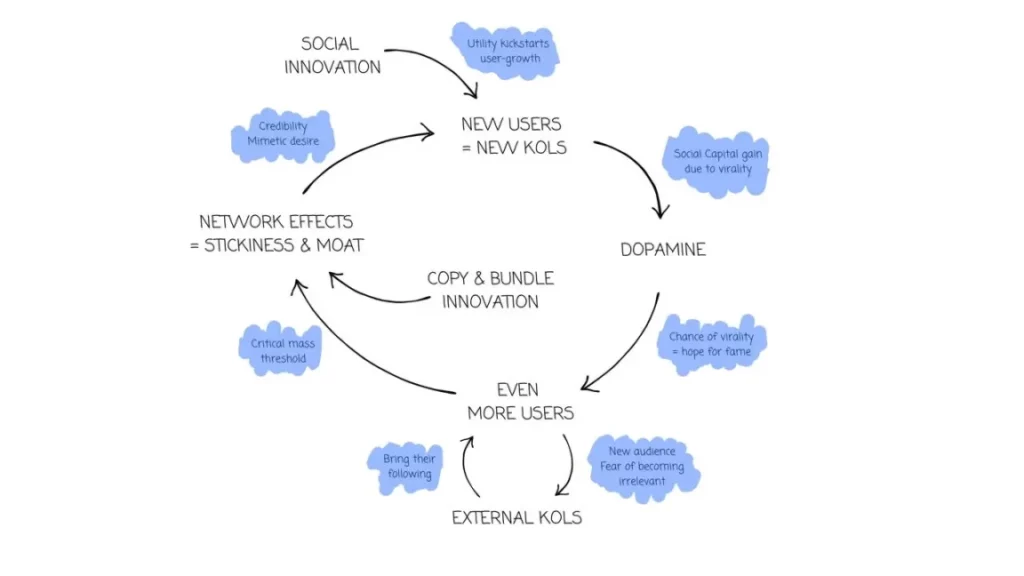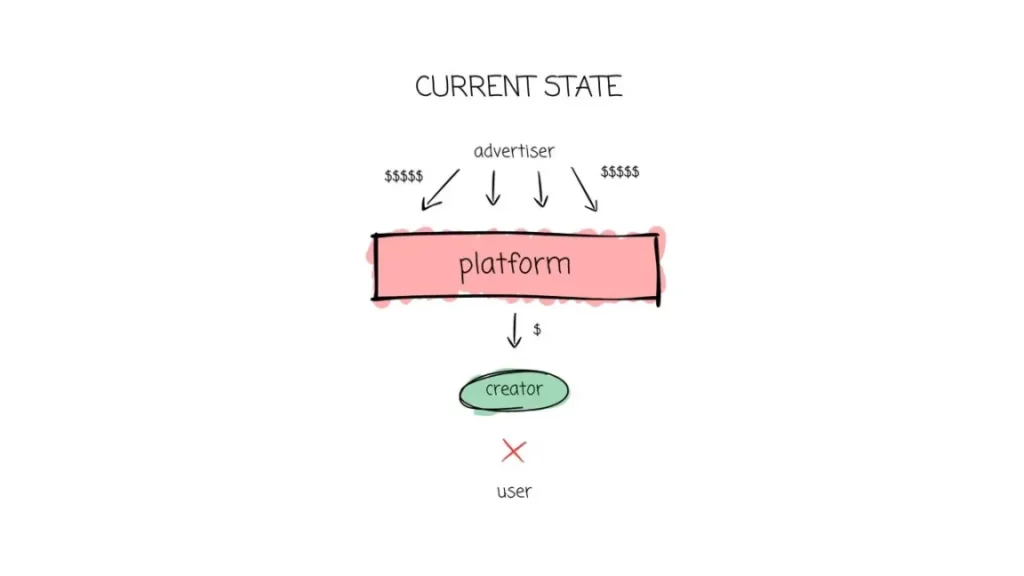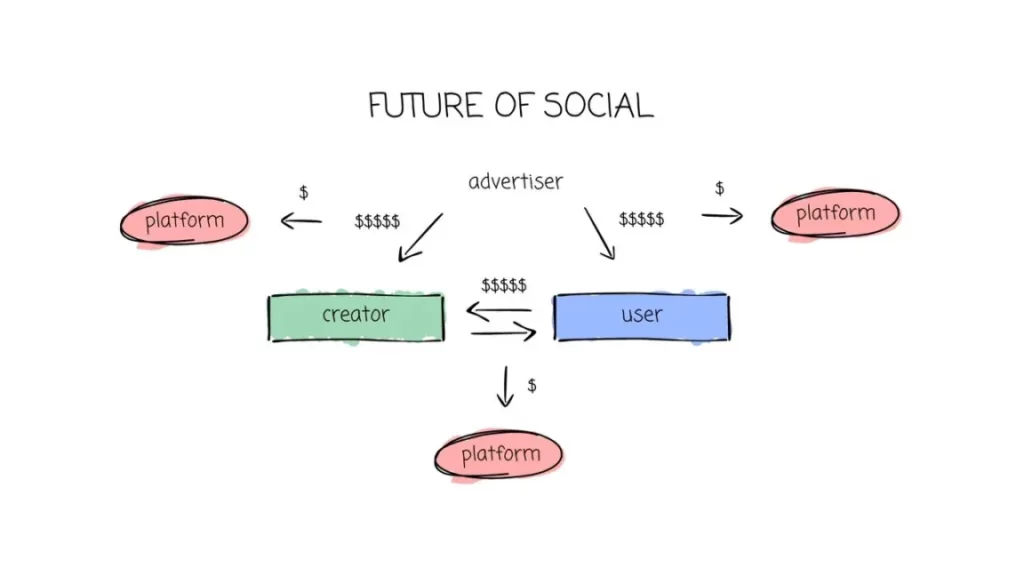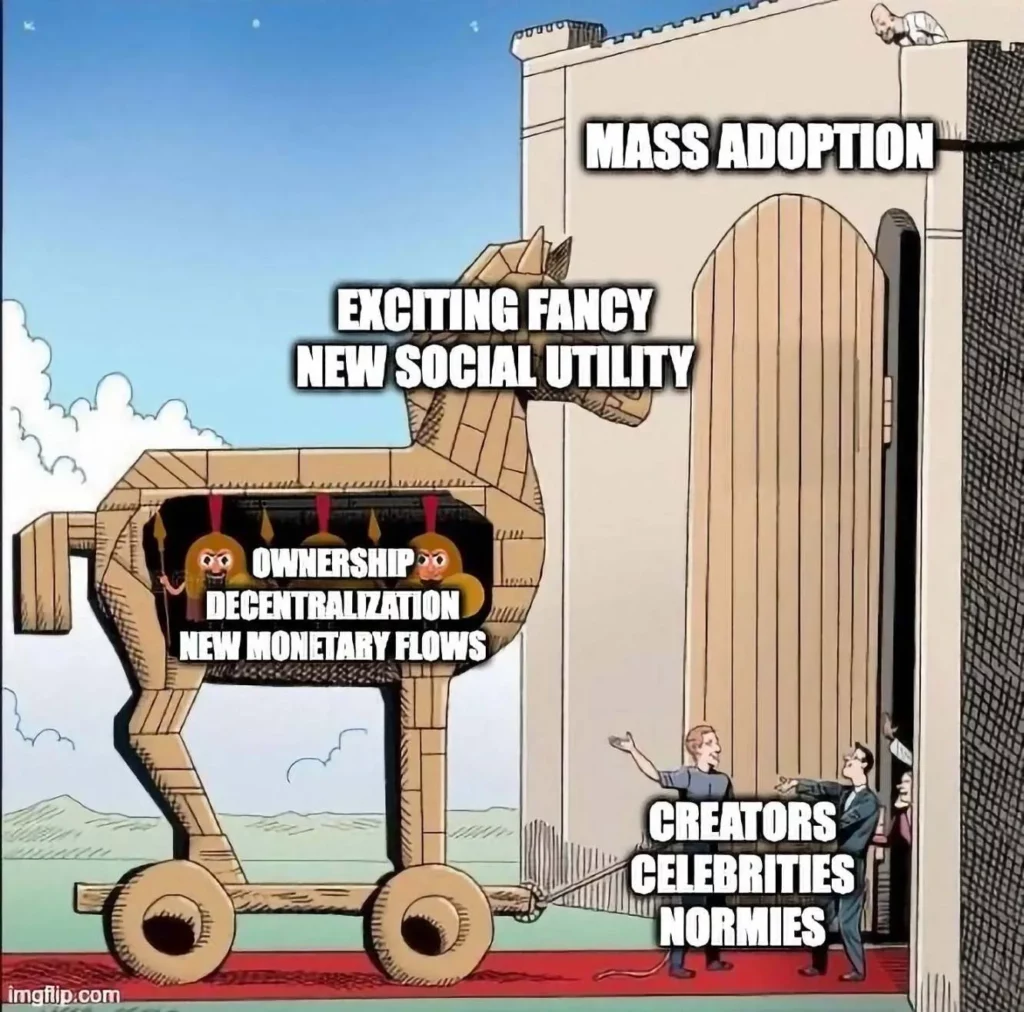SocialFi 2.0: Turning Attention as a New Financial Asset
Clubhouse – we all remember its golden era. In January 2021, during the pandemic, Clubhouse seemed to be on everyone’s lips. It skyrocketed to the top of app charts with its audio chat rooms. Initially available only to iPhone users and requiring an invite to join, it generated a lot of buzz, with invites even being raffled and sold. But just as quickly as Clubhouse rose, it also swiftly declined.
Fast forward to 2024, the SocialFi sector seems to have a new Clubhouse moment every other week. New and exciting SocialFi apps are constantly emerging. The two most notable recent ones are Friendtech and FantasyTop. While some people are still using these apps, they face sustainability challenges. Why is this?
As Eugene Wei wrote in “Status as a Service,” a successful social network relies on three core pillars:
- The potential to accumulate social capital, i.e., identity
- A measure of entertainment that people get from the platform
- Practicality, which we describe as the general tangible value people can extract
Initially, identity on social platforms was mainly achieved through “proof of work,” where those who added value became the network’s elite. However, SocialFi platforms like Friendtech have replaced actual value with financial incentives, leading to dynamic problems.
In October 2023, Friendtech had over 70,000 daily active users, but this number has dropped to just around 400 today. Let’s revisit these three pillars to see what went wrong with Friendtech. Initially, users gained identity by holding keys and joining unique but expensive groups. The dopamine rush was real when people saw their investments double overnight.
However, the third pillar – actual value – was missing. The main use case was speculation, with users hoping to increase their portfolio value and receive airdrops. Interaction with favorite creators was just an afterthought for most.

When key prices dropped, the dopamine disappeared, and there wasn’t enough actual value to sustain user engagement. Successful creators found managing another account cumbersome, and as fees decreased, their participation declined, leading to the platform’s downfall.
FantasyTop followed a similar path. It started strong in April 2024 with five-figure daily active users but now hovers around 2,000 to 3,000 daily active users.
Unlike Friendtech, FantasyTop is more like a game with social features, akin to fantasy sports such as fantasy football. Speculation drove initial interest, with card prices rising and creators focusing on achieving good results. But as prices dropped and fees disappeared, so did the interest. Currently, FantasyTop is transitioning to a fantasy sports app with DraftKings features to regain users. Most users are still staying for potential airdrops.
These applications and the core issue of SocialFi lie in their heavy reliance on financial incentives. As these incentives diminish, user engagement declines, creating a vicious cycle. We’ve seen this pattern in many notable examples like Axie Infinity and Stepn. People tend to stick to established platforms because financial incentives should be a feature, not the main driver, while practicality should be the main pillar.
On the other hand, Orb and Warpcast are decentralized applications (dapps) that target the Web3 ideals of ownership and decentralization. Unlike mainstream social media giants, these platforms prioritize user control over their content. At first glance, they seem like the future of social networks. But upon closer inspection, they face a significant challenge: a lack of actual practicality. While they can theoretically match Instagram and Twitter in entertainment value with the right network effects, they don’t offer much in terms of value.
Consider the scenario of a typical 15-year-old girl using social media. She’s not concerned about whether she truly owns her photos or texts. Instead, she focuses on followers, likes, interactions, and following her idols. Ownership and decentralization are far removed from her concerns.
As Peter Thiel said, from the perspective of the social experience, the current form of ownership and decentralization doesn’t transform the user experience from 0 to 1, nor does it make it ten times better. Instead, these ideals only offer marginal improvements. While they may attract tech enthusiasts, they lack the revolutionary appeal to convince ordinary users to leave familiar platforms.
Currently, the state of SocialFi applications is challenging. They initially rely on speculation to drive capital and user influx, which remains an inevitable growth factor but is temporary. Although decentralization is important, users prioritize the value the product offers. For long-term sustainability, these networks need to develop enough value to keep users engaged beyond the initial monetary game.
To attract a broad user base, crypto must shift from purely financialized products to those that can tap into the attention economy. If we consider speculation as a fun addition rather than a necessity and step out of the Web3 bubble for broader attention, SocialFi can become one of the biggest verticals. You might ask, how can this be achieved?
Thinking Outside the Crypto Bubble While Integrating Web3
To understand SocialFi’s impact, we first need to examine the dynamics of Web2:
Traditional social media, undoubtedly one of the most used parts of the internet, succeeds through clear flywheel effects. Social innovation – offering new use cases with actual value – often goes viral, leading to the emergence of new KOLs. This viral opportunity attracts many users, driven by the hope of fame and attention.
The dopamine rush from interactions, likes, and exposure – possibly the most consumed “drug” of the 21st century.
This influx of users attracts existing KOLs who want to reach new audiences and fear becoming irrelevant. In turn, this enhances the platform’s credibility and accelerates user adoption. As this positive feedback loop continues, network effects strengthen, creating a moat and increasing user stickiness.
However, with shortening user attention spans and decreasing patience, platform operators face immense pressure to evolve, ideally leading to further social innovation and restarting the cycle. We all remember the early days of Instagram.
It started as a simple tool for capturing, editing, and sharing pictures with followers. It quickly became a must-have app on everyone’s phone. But like any successful platform, Instagram had to evolve to stay relevant.
In 2016, driven by the skyrocketing popularity of Snapchat Stories, Instagram faced immense pressure to adapt. To counter this competitive threat, Instagram launched its version, not only mimicking the feature but even adopting the same name. This strategic move aimed to retain user engagement directly and maintain relevance in the dynamic social media landscape.
And this was just the beginning. They soon integrated algorithmic pushes to help users discover content more easily and capture their attention more effectively. Shortly after, Reels emerged as a direct response to TikTok’s explosive popularity.
The message from Instagram’s evolution was clear: copy and integrate others’ innovations rather than be left behind.

So, what does this mean for SocialFi?
Speculation and financialization are undoubtedly interesting features of SocialFi but should not be the main unique selling proposition (USP). Instead, the value proposition should focus on social innovation and new use cases to kickstart the flywheel.
The key question is: how can we use Web3 elements to create new and exciting social experiences that challenge Meta, TikTok, and X?
Obviously, we don’t have the definitive answer. If we did, we wouldn’t be sitting here telling you this but instead fully immersed in building and competing with Zuckerberg and Elon.
While we don’t have all the answers, we have some ideas that can inspire developers to create novel social use cases.
Attention as a New Financial Asset
In the Web3 era, we excel at creating new financial assets. Currently, social media is a battlefield for attention. While content grows exponentially, attention spans are shortening, making attention a scarce asset. Attention is represented through tools like likes, comments, follows, exposure, and time spent on platforms. However, these tools are highly inflationary and are currently available for unlimited use.
Thus, despite attention being scarce, the infinite abundance of attention tools dilutes its value. As each tool garners less attention, its quality diminishes.
Imagine if Web3 enabled the tokenization of these tools, making them scarce or at least inflation-resistant assets, with decentralized social platforms acting as their marketplaces. Likes, comments, and follows could become forms of attention tokens, carefully allocated to users and eventually redistributed to their favorite creators. This would encourage users to manage their feeds more selectively and motivate creators to produce high-quality content.
Following Eugene Wei’s three key pillars, this would shift entertainment towards greater utility. The overall share of attention per piece of content would increase, potentially attracting major advertisers seeking high-quality engagement.
Alternatively, imagine followers themselves could be financial assets, with their value varying based on their social graph. If you managed to have a high-profile user, like Vitalik or Ansem, follow you, you could sell this rare follow “voucher” to someone willing to pay for their attention.
While these ideas are clearly abstract and need further refinement, they illustrate a potential direction.
More practical use cases might involve tokenizing the intellectual property (IP) of content. Coinbase recently highlighted this in their new “Mister Miggles” campaign, addressing current issues in the creator economy and urging everyone not just to create but also to consume on-chain.
Story Network is further developing this idea. They are creating a new Layer 1 blockchain that enforces programmable IP and licensing at the protocol level, allowing people to legally register their IP globally as new financial assets.
Imagine applying this to decentralized social networks.
Take the example of “Financial Girl,” who went viral worldwide. Imagine if this video was posted on a platform powered by Web3 technology on the backend, directly tokenizing its IP and allocating some of the earnings to those who initially helped it go viral, like her early followers.
Such a mechanism would allow social creators to be viewed similarly to NFT collectibles or brands, with their early followers acting as their NFT community. Each creator would thus have a loyal, incentivized superfollower group helping them spread content online, accelerating their success while directly participating in it. We’re talking about not just monetary rewards but also the non-monetary value of social capital from your favorite creators—like getting backstage passes when “Financial Girl” performs with David Guetta.
However, no matter how we view this, we always come back to an inevitable feature.
Making Communities Great Again
Users need to be prioritized again. This has always been a core characteristic of Web3, and if applied to social platforms, it could become its most powerful feature since network effects are crucial here.
Here’s the current value distribution, whether we discuss Web2 or Web3 social platforms:

As Chris Dixon mentioned in his recent book “Reading, Writing, Owning,” the top 1% of social networks (like Meta and TikTok) control 95% of social network traffic and 86% of social mobile traffic. The value created by advertisers is mostly monopolized by these platforms, with minimal returns for creators, and users receive no returns at all, despite creating the necessary network effects. We aim to significantly improve value flow through decentralized social platforms, allowing creators and users to participate more directly in the value they create.

By breaking the monopoly of platform operators as intermediaries between attention providers (consumers and creators) and attention seekers (advertisers), we envision a future with more equitable value distribution. Income should be proportionally distributed to those who earn it or directed to the creator’s community.
Therefore, establishing a moat solely through controlling network effects will become more difficult. We believe we’ll see a significant deconstruction, with various vertically integrated niche social platforms attempting to accumulate multiple revenue streams instead of a single platform horizontally controlling value flow.
As long as operators create sufficient value for both suppliers and seekers, their social platforms will thrive. In such a case, they will act as marketplaces between these parties, fairly sharing the value they facilitate.
Imagine future social platforms as the OpenSeas of attention.
Conversely, we go a step further, suggesting that creators should redistribute all platform revenues to their most active audiences in exchange for social capital.
Status as the New Ponzi Scheme
Today, we live in a world where social capital is often more valuable than monetary capital. If done right, status can generate money, even large and sustainable amounts. Conversely, money rarely buys recognition and fame.
Status can open doors that money alone cannot. Imagine getting exclusive VIP seats for the Super Bowl, securing last-minute reservations at the trendiest restaurant for your anniversary, or attracting the attention of powerful and influential figures like celebrities or politicians.
These connections and opportunities, if utilized correctly, can have profound impacts. For KOLs and creators, nothing is more valuable than their reputation. We believe that building new social platforms that enable them to directly give back value to their communities will create a flywheel effect of social capital growth, similar in acceleration and leverage to what we see in Ponzi schemes.
Take Pudgy Penguins as a perfect example. They became the most popular brand and are now even expanding into the non-Web3 world simply because they committed to giving back value to their NFT holders, creating a powerful distribution network.
Another example is Mr. Beast, the biggest YouTuber ever. While his content is indeed entertaining, his secret to success has always been reinvesting most of his income into the entertainment value of his content or giving back to his community through giveaways.
This could be the most powerful market entry and growth strategy for those looking to increase their social capital from scratch. It significantly enhances the relationship between creators and consumers, potentially leading to greater engagement and support. As a result, these creators’ social capital and status will continue to rise, enriching their most loyal communities.
Coding such mechanisms at the protocol level could even serve as a launchpad for creating and owning new influencers.
How to Become Famous with a Killer Feature
Even if this desire varies more or less among individuals, everyone has thought about what it would be like to be a celebrity or have all the attention around them.
Social media provides a platform to achieve this dream, which is exactly what everyone posting daily, tweeting, or sharing on TikTok hopes for: the tiny chance of going viral to gain all the attention and become famous.
However, competing for attention and the favor of algorithms is not only fierce but also opaque, extremely complex, and often frustrating.
Blockchain, with its open-source nature, fits perfectly here.
Imagine a social media platform where the rules of algorithmic favoritism are immutably encoded on the backend, transparent, and fairly accessible to every user and creator. You could even expand on this, including analytics and metrics on current trends, the most popular content, and more.
Now combine this relatively complex data set with gamification mechanisms, and voila, you’ve built an open and fair framework to help users easily achieve viral growth.
No more excuses—if people don’t like your content, it’s because the content itself isn’t appealing enough.
Thus, we aim to conclude this topic slowly but surely.
Conclusion
While we may have been somewhat critical of the current SocialFi market, we have many exciting ideas for new use cases.
The basic flywheel of social growth remains unchanged, but Web3 elements can accelerate these processes and enhance user retention. While we encourage founders to avoid focusing solely on monetary incentives, tokenization and financialization mechanisms can undoubtedly play a role in driving social innovation.
In our view, the potential for significantly new experiences is what sets decentralized social apart from other crypto sectors. Web3 elements seem capable of enabling significant new experiences on an unprecedented scale, which should also attract the interest of people outside our fallen bubble.
We also strongly support starting as a simple tool built on existing social networks like X or Instagram. This strategy can effectively kickstart growth and ensure a smooth user experience while focusing on delivering a strong value proposition.
FantasyTop is a prime example of this approach. This not only brought explosive growth in their initial phase but also holds potential for further development if they can expand their user base and increase engagement.
Who knows, if we do it right, we might even leverage these same experiences to ultimately impose the real added value of ownership, decentralization, and new monetary flows as a secret Trojan Horse to the masses.
